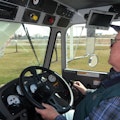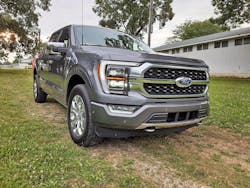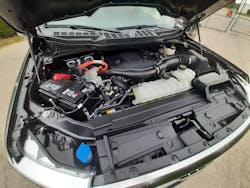The Ford F-150 full hybrid pickup truck is loaded with high-tech features, and like most pickups today, rather pricey. The 2021-model I drove is all of those things, starting with size: I almost couldn’t get past how large the truck was because I remember when they weren’t. In the past 20 or so years, all full-size pickups have grown substantially in length, width, and height. Builders say customers want bigger vehicles, and sales seem to prove it. In a good year, Ford sells more than 900,000 F-150s, and for more than 40 years—even when it was smaller—it’s been the single-most popular vehicle in America. Ever-bigger F-150s created a widening gap in Ford’s product line that it deftly filled in model-year 2019 with a reborn Ranger, now a midsize truck instead of the compact it was when discontinued in 2011. And that left space for the compact, car-based Maverick, which came out only recently.
The increased size of the F-150’s cab translates to cavernous interior room. In front there’s a pair of bucket seats and a wide, deep console; and in this 4-door SuperCrew, a large rear-seat area offered seating for three and lots of leg room. Plus, with the seat backs folded down, there was storage for lots of stuff you’d rather not plunk in the truck bed. Ford offers six trim levels in this series, starting with the austere XL and ascending to the plutocratic Limited. This truck had Platinum trim, the second-highest level with two-tone stitched leather panels and seat covers, heated and ventilated seats, and a panoramic two-section glass sunroof.
“Ohhhh,” said people I showed the truck to in the week I had it. “This is nice.” How nice should a truck be? Certainly this F-150 could do a lot of work, like haul 2,120 pounds of payload and tow up to 12,700 pounds, according to Ford’s specs. But I decided it’s really a Lincoln Town Car disguised as a pickup, nicer even than the early 2000s Lincoln Blackwood and Mark LT, both gussied-up F-150s. Lincoln-like poshness is alive in the upper trim levels Ford now offers, and executives say it’s what most retail customers want, even if they use their pickups for both work and play.
How does the F-150 Hybrid perform?
For sure the truck was fast, whether off the line or at any speed on any highway. Punch the accelerator pedal and it’d go, thanks to the PowerBoost Full Hybrid Electric powertrain: an EcoBoost twin-turbocharged 3.5-liter gasoline V-6 backed by a 10-speed automatic transmission and a 47-horsepower Borg Warner electric motor drawing juice from a lithium-ion battery pack. The combination produces as much as 430 horsepower and 570 lb.-ft. of torque, Ford says. PowerBoost is the identifier, for there were no other “hybrid” badges on the truck. The engine, electric motor, or both propel the truck, depending on conditions and power demanded by a driver. With my light foot, it would usually start out on electric power and the engine kicked in at 15 to 25 mph. While coasting and while stopped at traffic lights, the engine shut off. Some people don’t like this, but I do because it punctuates the hybrid system’s fuel-saving, fume-reduction ability. EPA rates the PowerBoost hybrid at 24 mpg Combined, though the readout in the digital instrument panel said it was getting 21 to 22. That’s 5 to 7 mpg City more than a non-hybrid F-150 with a comparable V-6, but about the same Highway rating.
Click here for a look inside the Ford F-150 Hybrid pickup truck.
That readout also said the truck dropped to 19 and 20 mpg while towing a 4,000-pound boat and trailer. They belonged to my stepson, a fan of Ford products who quickly decided that this could be his next truck—except he now works from home and no longer commutes, and is preparing to sell that boat. He had replaced the water pump on its inboard GM 350 V-8, so we pulled it to a lake about 10 miles away. Mike appreciated the truck’s pulling ability, and I liked its 4x4 sure-footedness on the launch ramp. The F-150’s system included the usual 2 HI and part-time 4 HI and 4 LO, plus 4A, for full-time all-wheel drive that automatically splits power between the front and rear axles. Any of them could be picked with push buttons that electrically engaged or disengaged the transfer case. At one point I somehow got it into 4 HI, even though the 2 HI light was on, and the wheels hopped a bit during turns. I punched 4A and the drivetrain smoothed out; later I returned it to 2 HI.
The 4x4 buttons surrounded a knob that let me select driving modes, among them Performance, Eco, and Tow-Haul. On steep highway grades, Perf and Tow-Haul will delay upshifts and more aggressively downshift the 10R80 10-speed automatic. But we were running on level roads so I left that alone. I did watch the tranny’s gear readout and noted that it sometimes skip-shifted from 1st to 3rd while starting out, but otherwise used all the gears while accelerating. It stayed in 7th and 8th at boulevard speeds of 35 to 40 mph, then upshifted further. First is 4.70:1, 7th is 1:1 direct (where engine rpm matches the driveshaft’s speed), and the top three ratios are overdrives—0.85, 0.69 and 0.64. So gear steps are small, keeping engine revs really low unless I put my foot into it. Ford co-developed this 10-speed autotranny with General Motors.
At all speeds the truck was limousine-quiet, a virtue courtesy of the loafing engine and almost silent electric motor, and suggesting that a lot of insulation was tucked in the walls and floor. Rolling down the power windows introduced some wind noise, but less than I expected. Many things were electrically powered or controlled, including the running boards that swung out as I approached the truck (it sensed the fob in my pocket) or opened the door, then folded in; the parking brake, actuated with a big knob under the dash; and the transmission selector, which automatically shifted into Park if I prematurely shut off the engine with the Push to Start/Stop button on the dash.
The suspensions, though, were mechanical, and the ride was smooth for a burly truck. Early on I took it onto the county fairgrounds near my house and aimed for some potholed roads and then, to simulate mild off-roading, onto an expanse of mowed but ungroomed grass. The springs soaked up most bumps and had me wondering if the rear end sat on air bags. No, they were leaf springs, and they worked well with the shock absorbers. It is a venerable but obviously highly refined design.
A manufacturer’s sticker I found in the glovebox listed too many features to name, such as electrical outlets inside the cab and in the bed, good for 110 and 220 volts (I meant to plug in a circular saw and try one out, but didn’t get around to it), and parallel park assist. We did try Pro Backing Assist, which enables a rookie to maneuver a trailer with a knob instead of the steering wheel, but it required some learning. We decided it’s kind of silly for guys who already know how to back trailers.
Some high-tech features I used a lot: The colorful and clearly displayed backup camera system with “bird’s eye view,” which was helpful in tight quarters; Blue Cruise, Ford’s adaptive speed control that kept pace with traffic ahead, even braking the F-150 to a stop and accelerating when the traffic moved again; lane-keeping assist, which steered between painted stripes but required my hands on the wheel; and adaptive steering that, unless I signaled, discouraged me from changing lanes by tugging on and vibrating the steering wheel. An electronic nanny flashed audible and visual warnings when I didn’t mind my techie manners. Finally, did I say pricey? That sticker did not include any pricing data, but I found online info that indicated this F-150 would list at about $80,000.
About the Author

Tom Berg
Tom Berg is widely acknowleged as one of the top truck writers in the industry. He has covered construction for more than 34 years, and has test-driven well over 150 trucks for Construction Equipment.

